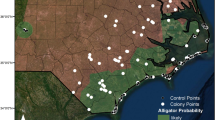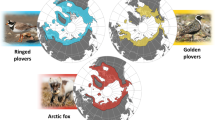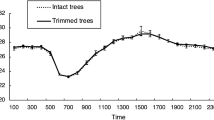Abstract
Alarming global-scale declines of bird numbers are occurring under the changing climate1, and species belonging to alpine and Arctic tundra are particularly affected2,3. Increased nest predation appears to be involved4, but the mechanisms linking predation to climate change remain to be shown. Here we test the prediction from food web theory that increased primary productivity (greening of tundra) in a warming Arctic leads to a higher risk of nest predation in tundra ecosystems. By exploiting landscape-scale spatial heterogeneity in areas of primary productivity across alpine tundra ecotones and supplied with experimental nests in sub-Arctic Scandinavia, we found that predation risk indeed increased with primary productivity. The productivity-predation risk relation was independent of the simultaneous effects of rodent population dynamics and vegetation cover at nest sites. Predation risk also increased steeply with altitude, implying that species at the high-altitude end of the alpine tundra ecotones are particularly vulnerable. Our study contributes to an improved understanding of how climate change may affect Arctic and alpine ecosystems and threaten endemic biodiversity through a trophic cascade.
This is a preview of subscription content, access via your institution
Access options
Access Nature and 54 other Nature Portfolio journals
Get Nature+, our best-value online-access subscription
$29.99 / 30 days
cancel any time
Subscribe to this journal
Receive 12 print issues and online access
$209.00 per year
only $17.42 per issue
Buy this article
- Purchase on Springer Link
- Instant access to full article PDF
Prices may be subject to local taxes which are calculated during checkout


Similar content being viewed by others
Code availability
The R code used to analyze the data is available from the corresponding author upon request.
Data availability
The data that support the findings of this study are available from the corresponding author upon request.
References
Stephens, P. A. et al. Consistent response of bird populations to climate change on two continents. Science 352, 84–87 (2016).
Elsen, P. R. & Tingley, M. W. Global mountain topography and the fate of montane species under climate change. Nat. Clim. Chang. 5, 772 (2015).
Meltofte, H. Arctic Biodiversity Assessment. Status and Trends in Arctic Biodiversity: Synthesis (Conservation of Arctic Flora and Fauna, 2013).
Kubelka, T. et al. Global pattern of nest predation is disrupted by climate change in shorebirds. Science 362, 680–683 (2018).
Post, E. et al. Ecological dynamics across the arctic associated with recent climate change. Science 325, 1355–1358 (2009).
Tingley, M. W., Monahan, W. B., Beissinger, S. R. & Moritz, C. Birds track their Grinnellian niche through a century of climate change. Proc. Natl Acad. Sci. USA 106, 19637–19643 (2009).
Lehikoinen, A., Green, M., Husby, M., Kålås, J. A. & Lindström, Å. Common montane birds are declining in northern Europe. J. Avian Biol. 45, 3–14 (2014).
Elmhagen, B., Kindberg, J., Hellstrom, P. & Angerbjorn, A. A boreal invasion in response to climate change? Range shifts and community effects in the borderland between forest and tundra. Ambio 44, S39–S50 (2015).
Callaghan, T. V. et al. Ecosystem change and stability over multiple decades in the Swedish subarctic: complex processes and multiple drivers. Philos. Trans.R. Soc. B 368, 20120488 (2013).
Blois, J. L., Zarnetske, P. L., Fitzpatrick, M. C. & Finnegan, S. Climate change and the past, present, and future of biotic interactions. Science 341, 499–504 (2013).
Dawson, T. P., Jackson, S. T., House, J. I., Prentice, I. C. & Mace, G. M. Beyond predictions: Biodiversity conservation in a changing climate. Science 332, 53–58 (2011).
Martin, T. E. Avian life history evolution in relation to nest sites, nest predation, and food. Ecol. Monogr. 65, 101–127 (1995).
Martin, T. E. Nest predation and nest sites: New perspectives on old patterns. Bioscience 43, 523–532 (1993).
Ibáñez-Álamo, J. D. et al. Nest predation research: recent findings and future perspectives. J. Ornithol. 156, 247–262 (2015).
Chapin, F. S. III et al. Role of land-surface changes in Arctic summer warming. Science 310, 657–660 (2005).
Xu, L. et al. Temperature and vegetation seasonality diminishment over northern lands. Nat. Clim. Chang. 3, 581 (2013).
Legagneux, P. et al. Arctic ecosystem structure and functioning shaped by climate and herbivore body size. Nat. Clim. Chang. 4, 379 (2014).
Myers-Smith, I. H. et al. Climate sensitivity of shrub growth across the tundra biome. Nat. Clim. Chang. 5, 887 (2015).
McKinnon, L. et al. Lower predation risk for migratory birds at high latitudes. Science 327, 326–327 (2010).
Ims, R. A. & Fuglei, E. Trophic interaction cycles in tundra ecosystems and the impact of climate change. Bioscience 55, 311–322 (2005).
Gilg, O. & Yoccoz, N. G. Ecology. Explaining bird migration. Science 327, 276–277 (2010).
Oksanen, L. & Oksanen, T. The logic and realism of the hypothesis of exploitation ecosystems. Am. Nat. 155, 703–723 (2000).
Maron, J. L. & Harrison, S. Spatial pattern formation in an insect host-parasitoid system. Science 278, 1619–1621 (1997).
Henden, J. A., Ims, R. A., Fuglei, E. & Pedersen, Å. Ø. Changed Arctic-alpine food web interactions under rapid climate warming: Implication for ptarmigan research. Wildlife Biol. SP1, 1–11 (2017).
Sokolov, A. A., Sokolova, N. A., Ims, R. A., Brucker, L. & Ehrich, D. Emergent rainy winter warm spells may promote boreal predator expansion into the Arctic. Arctic 69, 121–129 (2015).
Roslin, T. et al. Higher predation risk for insect prey at low latitudes and elevations. Science 356, 742–744 (2017).
Andrén, H. Corvid density and nest predation in relation to forest fragmentation: A landscape perspective. Ecology 73, 794–804 (1992).
Storch, I., Woitke, E. & Krieger, S. Landscape-scale edge effect in predation risk in forest-farmland mosaics of central Europe. Landsc. Ecol. 20, 927–940 (2005).
Killengreen, S. T., Strømseng, E., Yoccoz, N. G. & Ims, R. A. How ecological neighbourhoods influence the structure of the scavenger guild in low Arctic tundra. Divers. Distrib. 18, 563–574 (2012).
Ims, R. A., Henden, J.-A., Thingnes, A. V. & Killengreen, S. T. Indirect food web interactions mediated by predator–rodent dynamics: relative roles of lemmings and voles. Biol. Lett. 9, 20130802 (2013).
Marolla, F. et al. Assessing the effect of predator control on an endangered goose population subjected to predator-mediated food web dynamics. J. Appl. Ecol. 56, 1245–1255 (2019).
Moen, A, Lillethun, A. & Odland, A. Vegetation. (Norwegian Mapping Authority: 1999).
Bateman, P. W., Fleming, P. A. & Wolfe, A. K. A different kind of ecological modelling: the use of clay model organisms to explore predator–prey interactions in vertebrates. J. Zool. 301, 251–262 (2017).
McKinnon, L. et al. Suitability of artificial nests—response. Science 328, 46–47 (2010).
Haftorn, S. Birds of Norway (Universitetsforlaget Oslo, 1971).
Ims, R. A., Yoccoz, N. G. & Killengreen, S. T. Determinants of lemming outbreaks. Proc. Natl Acad. Sci. USA 108, 1970–1974 (2011).
Ims, R. A. et al. Ecosystem drivers of an Arctic fox population at the western fringe of the Eurasian Arctic. Polar Res. https://doi.org/10.1080/17518369.2017.1323621 (2017).
Huete, A. et al. Overview of the radiometric and biophysical performance of the MODIS vegetation indices. Remote Sens. Environ. 83, 195–213 (2002).
Andrén, H., Angelstam, P., Lindstrom, E. & Widen, P. Differences in predation pressure in relation to habitat fragmentation - an experiment. Oikos 45, 273–277 (1985).
Donovan, T. M., Jones, P. W., Annand, E. M. & Thompson, F. R. Variation in local-scale edge effects: Mechanisms and landscape context. Ecology 78, 2064–2075 (1997).
Kurki, S., Nikula, A., Helle, P. & Lindén, H. Landscape fragmentation and forest composition effects on grouse breeding success in boreal forests. Ecology 81, 1985–1997 (2000).
Harju, S. M., Olson, C. V., Hess, J. E. & Bedrosian, B. Common raven movement and space use: influence of anthropogenic subsidies within greater sage‐grouse nesting habitat. Ecosphere 9, e02348 (2018).
Walton, Z., Samelius, G., Odden, M. & Willebrand, T. Variation in home range size of red foxes Vulpes vulpes along a gradient of productivity and human landscape alteration. PLoS ONE 12, e0175291 (2017).
Didan, K. MOD13Q1 v006: MODIS/Terra Vegetation Indices 16-Day L3 Global 250 m SIN Grid (USGS, 2015).
Pinheiro, J. & Bates, D. Mixed-Effects Models in S and S-PLUS (Springer, 2000).
Bates, D., Machler, M., Bolker, B. M. & Walker, S. C. Fitting linear mixed-effects models using lme4. J. Stat. Softw. 67, 1–48 (2015).
Burnham, K. P. & Anderson, D. A. Model selection and multimodel inference: a practical information-theoretic approach 2nd edn (Springer, New York, 2002).
Nakagawa, S. & Schielzeth, H. A general and simple method for obtaining R² from generalized linear mixed-effects models. Methods Ecol. Evol. 4, 133–142 (2013).
Acknowledgements
Funding was provided by the projects EcoFinn, SUSTAIN and Climate-Ecological Observatory for Arctic Tundra (COAT). We thank E.H. Borge, S.-L. Nilssen, A.A. Olsen, Christian Hagstrøm and Mary-Ann J. Wara for assistance in the field. The very thorough and constructive comments of three anonymous reviewers helped us prepare the final version of the manuscript.
Author information
Authors and Affiliations
Contributions
R.A.I. and J.A.H. conceived the study. J.A.H. and J.U.J. analyzed the data. A.V.T., M.J.G. and M.A.S. conducted the experiment. R.A.I. wrote the manuscript with contribution from all authors.
Corresponding author
Ethics declarations
Competing interests
The authors declare no competing interests.
Additional information
Peer review information: Nature Climate Change thanks Katherine Selwood, Quentin Read and other, anonymous, reviewer(s) for their contribution to the peer review of this work.
Publisher’s note: Springer Nature remains neutral with regard to jurisdictional claims in published maps and institutional affiliations.
Supplementary information
Supplementary Information
Supplementary Tables 1–3, and Supplementary Figs. 1 and 2.
Rights and permissions
About this article
Cite this article
Ims, R.A., Henden, JA., Strømeng, M.A. et al. Arctic greening and bird nest predation risk across tundra ecotones. Nat. Clim. Chang. 9, 607–610 (2019). https://doi.org/10.1038/s41558-019-0514-9
Received:
Accepted:
Published:
Issue Date:
DOI: https://doi.org/10.1038/s41558-019-0514-9
This article is cited by
-
Predation risk and landscape properties shape reproductive output of an endangered sea duck from two subpopulations with contrasting predation risk
Journal of Ornithology (2023)
-
Trends in breeding performance in wader populations at Zackenberg, high Arctic Greenland, in relation to environmental drivers 1996–2018
Polar Biology (2021)
-
Climate change increases predation risk for a keystone species of the boreal forest
Nature Climate Change (2020)



